Abstract
Gut microbiota imbalances lead to the pathogenesis of non-alcoholic fatty liver disease (NAFLD), which is primarily accompanied by hepatic steatosis. Hydroxyphenyl propionic acids (HPP) have shown great potential in inhibiting lipid accumulation but their protective effects concerning NAFLD and intestinal microbiota have remained unclear. In this paper, we investigated the efficacies of 3-HPP and 4-HPP on hepatic steatosis and gut flora in mice fed a high-fat diet (HFD). We found that 3-HPP and 4-HPP administration decreased body weight and liver index, ameliorated dyslipidemia, and alleviated hepatic steatosis. Furthermore, 3-HPP and 4-HPP enhanced the multiformity of gut microbiota; improved the relative abundance of GCA-900066575, unidentified_Lachnospiraceae, and Lachnospiraceae_UCG-006 at genus level; increased concentration of acetic acid, propionic acid and butanoic acid in faeces; and reduced systemic endotoxin levels in NAFLD mice. Moreover, 4-HPP upregulated the relative abundance of genera Rikenella and downregulated the relative abundance of Faecalibaculum. Furthermore, 3-HPP and 4-HPP regulated lipid metabolism and ameliorated gut dysbiosis in NAFLD mice and 4-HPP was more effective than 3-HPP.
1. Introduction
Non-alcoholic fatty liver disease (NAFLD) is a disorder in which lipid accumulation appears in more than 5% of the liver without excessive alcohol consumption [1]. As prevalent chronic liver diseases worldwide, NAFLD harms billions of people and the disease can develop to steatohepatitis, fibrosis, cirrhosis, and hepatocellular carcinoma [2]. The hallmark of NAFLD is excessive neutral lipids such as triglyceride (TG) and cholesterol accumulation in hepatocytes [3]. The acquisition of TG and cholesterol in the liver includes biosynthesis from acetyl CoA or importation from blood; their disposal occurs through delivery to blood or conversion to other molecules [4,5]. As the liver was not served as a lipid storage organ, imbalance among these processes gradually induces hepatic steatosis and dyslipidemia [4]. However, the pathogenesis of NAFLD is intricate and several studies have suggested that gut microbiota could regulate lipid metabolism [6,7].
Gut microbiota is a community of plentiful archaea, bacteria, eumycete, and bacteriophages that coexist in the colon; dysbiosis of this community has been repeatedly observed in NAFLD [8,9]. Aron-Wisnewsky et al. summarized that the relative abundance of Escherichia, Shigella, Ruminococcus, and Blautia is increased and Lactobacillus is decreased at the genera level in NAFLD patients by contrast to healthy volunteers [10]. Demir et al. found that the faecal fungi composition in fibrosis patients was characterized by a higher log-ratio of Mucor sp./Saccharomyces cerevisiae [11]. In the western diet-fed mice, gradually reducing abundances of Clostridia and Ruminococcaceae followed the occurrence of NAFLD [12]. Furthermore, the connection between gut flora and NAFLD was generally explored in recent years. A high-fat diet (HFD) failed to induce dyslipidemia and lipid accumulation of liver in germ-free (GM) mice [13]. However, transplanting gut flora from HFD fed mice to GM mice reproduced phenotypes of NAFLD such as fasting hyperglycaemia, insulinaemia, and hepatic steatosis [14]. These results demonstrated that gut microbiota played a causal role in NAFLD development. Several mechanisms may interpret how gut microbiota cause the pathogenesis of NAFLD. Desulfovibrio, Escherichia coli, and other gram-negative genus in gut microbiota could release endotoxins which would enter systematic circulation through impaired gut barriers [15]. It has been demonstrated that endotoxin induced low-grade inflammation by activating Toll-like receptor 4 signal pathway and caused lipid accumulation of liver by upregulating gene expression of fatty acid synthase (fasn) and acetyl-coenzyme A carboxylase α (acaca) [16,17]. Besides, short chain fatty acids (SCFA), derived from gut microbiota, could inhibit lipid accumulation, and suppress inflammation [18,19]. Therefore, the maintenance of microbial homeostasis is important for protection against NAFLD.
Hydroxyphenyl propionic acids (HPPs), widespread phenolic acid, were able to alleviate inflammation and decrease lipid content of adipocytes in vitro [20,21]. They came from biotransformation of other complex polyphenol by gut microbiota [22,23,24]. It has been extensively confirmed that polyphenol can shift gut flora populations by stimulating beneficial bacteria and reducing pathogenic microbial species [25,26,27]. Nevertheless, except for parent polyphenol, the impacts of HPPs on the richness and composition of gut microbiota in NAFLD were unclear. Therefore, the aim of this study was to investigate effects of 3-HPP and 4-HPP on gut flora and related lipid metabolism in HFD induced NAFLD model. Intraperitoneal injection was selected to enhance the bioavailability of HPPs. It is demonstrated that 3-HPP and 4-HPP altered the diversity and composition of gut microbiota, decreased serum lipid contents, and ameliorated lipid aggregation of liver.
2. Materials and Methods
2.1. Materials
Both 3-HPP (C9H10O3, FW 166.17, purity > 98%) and 4-HPP (C9H10O3, FW 166.17, purity > 98%) were obtained from Aladdin (Shanghai, China). Poly (ethylene glycol) average Mn400 (PEG400) and physiological saline were purchased from Solarbio (Beijing, China). The 3-HPP and 4-HPP were dissolved in PEG and diluted with physiological saline to 24 mg/mL. Assay kits used for the detection of aspartate transaminase (AST), TG, high-density lipoprotein (HDL-c), free fatty acid (FFA), LDL-c, alanine transaminase (ALT), and total cholesterol (TC) levels were provided by Jiancheng (Nanjing, China). The enzyme-linked immunosorbent assay (ELISA) kit for detecting endotoxin was obtained from Genelab (Beijing, China). RNA easy fast kits (DP451) used for RNA isolation were obtained from TIANGEN (Beijing, China) and SYBR qPCR Master Mix was from Vazyme (Nanjing, China). D12450J and D12492 were purchased from Research Diets, Inc. (New Brunswick, NJ, USA).
2.2. Animal Experimental Scheme
The method of the animal experiment was adapted from a previous work with minor modifications [28]. A total of 24 C57BL/6J mice (male, a month of age) were bought from Vital River Laboratory Animal Technology Co., Ltd. (Beijing, China) and housed under the SPF environment (22 ± 2 °C, 50% ± 5 humidity) with 12 h light-dark cycle. The mice had free access to water and feed. After acclimatization for 10 days, all mice were randomly assigned to four groups (n = six per group, three mice per cage): (1) the normal diet (ND) group raised by a normal diet (D12450J), (2) the HFD group raised by an HFD (D12492), (3) the 3-HPP group raised by an HFD, (4) the 4-HPP group raised by an HFD. The dosage and frequency of 3-HPP and 4-HPP administration were 24 mg/kg body weight (BW) and twice per week, respectively. Mice received 3-HPP and 4-HPP for 13 weeks by intraperitoneal injection and PEG with saline as a control. We recorded the BW and diet intake of the mice twice per week. All experimental procedures were conducted according to the Animal Experimental Ethics Committee of China Agricultural University (reference number: AW70702202-4-1) and followed the criterion of National Research Council Guidelines.
2.3. Sample Collection
On the 87th day, all mice were softly stimulated in a sterile box to collect fecal samples (5–6 grains per mouse). The feces of each mouse were loaded into a sterile cryovial and stored in a −80 °C refrigerator. All mice fasted for 16 h with enough water. Then they were intraperitoneally injected with 1% sodium pentobarbital for anaesthesia. After sacrifice, we collected serum, liver, and colon of mice, which were immediately stored on dry ice and then transferred to a −80 °C refrigerator until further use.
2.4. Measurements of Serum Biochemicals and Liver Lipids Levels
Not only the content of TG, HDL-c, TC, FFA, LDL-c, and endotoxin, but also the activity of AST and ALT in serum were measured following instructions of test kits. TC and TG in the liver were isolated with absolute ethyl alcohol and their content was determined as described in the serum. The levels of endotoxin in the serum were measured based on the ELISA assay kit instructions.
2.5. Histopathological Examination
The histopathological procedure was performed as a previous study with slight modifications [29]. The fresh liver was fixed with 4% paraformaldehyde and sliced. After fixation, the liver sample was dehydrated with 15% (w/v) and 30% (w/v) sucrose solution successively at 4 °C. Then the liver sample was embedded by an optimal cutting temperature compound, sectioned (6–7 μm) and stained with hematoxylin-eosin (H&E) or oil red o (ORO). The slices were then photographed using a microscope (Nikon, Tokyo, Japan) at 200× magnification.
2.6. RNA Extraction and Quantitative Real-Time Polymerase Chain Reaction (qRT-PCR)
The procedure for qRT-PCR followed a previous study with few modifications [30]. Total RNA in liver samples were extracted by following assay kit instructions and then reversely transcribed to cDNA. The reaction system of qRT-PCR contained 2 μL cDNA, 0.7 μL forward primer, 0.7 μL reverse primer, 6.6 μL ddH2O, and 10 μL SYBR qPCR Master Mix. The PCR program was run on the BioRad CFX96 System, which included a first step at 95 °C for 5 min, a second step for 40 PCR cycles of 95 °C for 10 S, 60 °C for 30 S, 72 °C for 15 S, and a last step for melting curve. The primers of targeted genes are shown in Table 1 and the results of qRT-PCR were normalized to the gapdh expression and calculated by the 2−∆∆Ct method.

Table 1.
Primers of qRT-PCR.
2.7. Gut Microbiota Analysis by 16S rRNA Sequencing
Procedures of 16S rRNA sequencing and analysis were developed from a published study with some modifications [31]. The DNA in mice feces was extracted by TIANamp Stool DNA Kit (TIANGEN, Beijing, China). After isolation, the quality and concentration of DNA were detected using Nanodrop 2000 (Thermo Fisher, Darmstadt, Germany) and 0.75% agarose gel electrophoresis (AGE). The V3-V4 regions of bacterial 16S rDNA were amplified by barcode primers (341F: CCTAYGGGRBGCASCAG; 806R: GGACTACNNGGGTATCTAAT) and DNA polymerase (NEB, Massachusetts, USA). Then, the 2% AGE was used to examine the quality of 16S rDNA amplification and recycled using a DNA Gel Extraction Kit with Magnetic Beads (Beyotime, Nanjing, China). The library was constructed according to the instructions of the TruSeq® DNA PCR-Free Sample Preparation Kit (Illumina, San Diego, CA, USA) and amplicon sequencing was performed on the NovaSeq 6000 platform.
2.8. Measurement of Short Chain Fatty Acids (SCFAs) Content in Feces
Analysis concentrations of SCFA was performed with reference to the method of Hsu et al. with slight modifications [32]. About 20 mg of mice feces were mixed with 800 μL 0.5% phosphoric acid solution which contained 2-ethyl butyric acid (internal standard) at the concentration of 10 μg/mL. After ultrasound and centrifugation, the supernatant was extracted with n-butanol. The qualitative and quantitative analysis of SCFA was accomplished using a GC/MSD system with an Agilent HP-FFAP capillary column (30 m × 0.25 mm × 0.25 µm) (Agilent Technologies Inc., Palo Alto, CA, USA). A mix of propionic acid, acetic acid, butyric acid, isobutyric acid, valeric acid, isovaleric acid, hexanoic acid, and isohexanoic acid (25 μg/mL each, Sigma, Saint Louis, MO, USA) was used for calibration. We calculated the concentration of these SCFA based on standard solutions corrected by internal standard and the integral area of sample curves.
2.9. Statistical Analysis
All data were expressed as means ± standard deviations (SDs). The difference between the four groups was analysed by one-way analysis of variance using SPSS 20.0. Duncan’s test was used for the comparison between groups. p < 0.05 was deemed significant for all tests. Non-metric multidimensional scaling (NMDS) was used to analyse discrepancies among samples. The key genera between the HFD and HPP (or ND) groups were analysed by the Wilcoxon rank sum test at p < 0.05. Phylogenetic Investigation of Communities by Reconstruction of Unobserved States 2 (PICRUSt2) and Kyoto Encyclopedia of Genes and Genomes (KEGG) databases were selected to predict the metabolic function of gut microbiota.
3. Results
3.1. HPPs Reduced BW and Liver Index in HFD Mice
To explore the influence of 3-HPP and 4-HPP on NAFLD, C57BL/6J mice were intraperitoneally administrated with 3-HPP and 4-HPP and continuously fed an HFD for 13 weeks (Figure 1A). The BW of mice in four groups was without a marked difference in the initial experimental period. After being raised by HFD for 13 weeks, the BW, BW gain, and liver index of HFD mice were significantly increased compared to ND mice (Figure 1B–D). The 3-HPP and 4-HPP treatments attenuated these characteristics without affecting energy intake, suggesting that the efficacy of 3-HPP and 4-HPP did not depend on decreased food intake (Figure 1E).
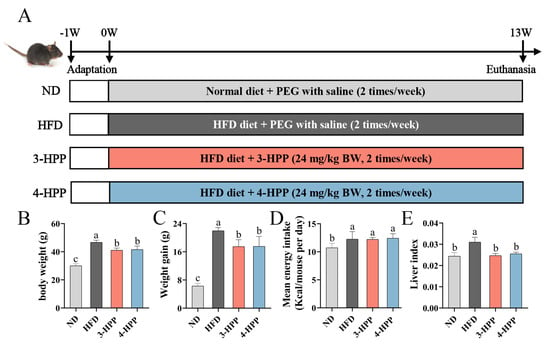
Figure 1.
The influence of 3-hydroxyphenyl propionic acid (3−HPP) and 4−HPP on physiological indexes. (A) Schematic diagram of animal experiment period. (B) Final body weight (BW). (C) BW gain. (D) Energy intake. (E) Liver index. Data are expressed as mean ± SD. n = 6 if not specified. According to Duncan’s test, mean values with different letters mean significant differences at p < 0.05.
3.2. HPPs Improved Hepatic Steatosis and Ameliorated Liver Injury
As the major organ involved in NAFLD, the histologic feature of the liver was examined by H&E and ORO staining. H&E staining revealed that an HFD-induced ballooning degeneration and large areas of lipid droplet vacuole were observed in HFD mice livers. Similarly, the stained ORO sections of HFD mice livers showed plenty of red lipid droplets, which illustrated lipid aggregation. However, areas of lipid droplet vacuole and red lipid droplet were reduced, and ballooning degeneration disappeared in histologic results following 3-HPP and 4-HPP interventions (Figure 2A). We then used test kits to detect liver lipid levels and found that hepatic TG and TC contents in HFD mice were obviously more than those in ND mice; this was decreased by 3-HPP and 4-HPP (Figure 2B,C). These results demonstrated that HPPs protected HFD mice from hepatic steatosis and hepatic lipid accumulation.
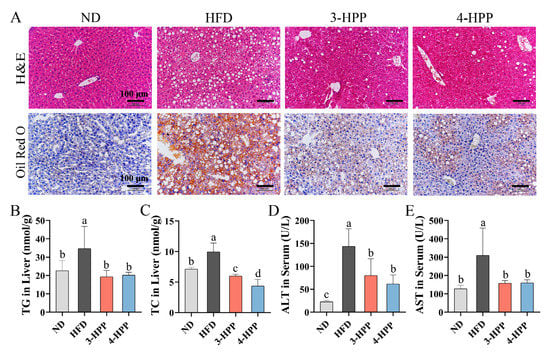
Figure 2.
The impacts of 3-HPP and 4-HPP on hepatic steatosis and liver injury. (A) Graphs of H&E staining and ORO staining. (B) Hepatic TG levels. (C) Hepatic TC levels. (D) Serum contents of ALT. (E) Serum contents of AST. Data are shown as the mean ± SD. n = 6 if not specified. According to Duncan’s test, mean values with different letters mean significant differences at p < 0.05.
Generally, ALT and AST contents in serum are deemed to be indicators of liver damage [33]. The serum contents of AST and ALT were sharply increased after HFD feeding for 13 weeks and ameliorated by 3-HPP and 4-HPP administration (Figure 2D,E). This indicates that HPPs can protect mice from hepatic injury.
Then we examined hepatic gene expression of de novo lipogenesis (DNL) (Figure 3A–D), including fasn, acaca, thyroid hormone responsive (thrsp), and elovl fatty acid elongase 6 (elovl6). Except for DNL, we also explored hepatic gene expression of TG and TC synthesis, including diacylglycerol O-acyltransferase 1 (dgat1), diacylglycerol O-acyltransferase 2 (dgat2), squalene epoxidase (sqle), and ATP citrate lyase (acly) (Figure 3E–H). Gene expression of thrsp and dgat2 was improved in HFD mice while 3-HPP and 4-HPP failed to reverse their upward tendency. However, 3-HPP and 4-HPP enhanced gene expression of peroxisome proliferator activated receptor alpha (ppara), which acts upstream of lipid metabolism (Figure 3I).
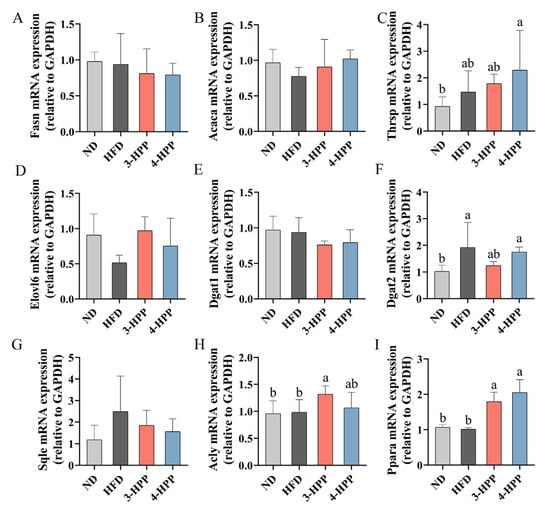
Figure 3.
The impacts of 3−HPP and 4−HPP on gene expression of hepatic lipid metabolism. mRNA expression of (A) Fasn, (B) Acaca, (C) Thrsp, (D) Elovl6, (E) Dgat1, (F) Dgat2, (G) Sqle, (H) Acly, and (I) Ppara in liver. Data are shown as the mean ± SD. n = 6 if not specified. According to Duncan’s test, mean values with different letters mean significant differences at p < 0.05.
3.3. HPPs Affected the Maker Levels in Serum
Clinical studies have found that the majority of NAFLD patients suffer from dyslipidemia [34]. Similarly, levels of lipids such as FFA, TG, and TC and lipoproteins (LDL-c and HDL-c) in HFD mice serum were significantly increased compared to ND mice (Table 2). Nevertheless, serum levels of TG, FFA, and TC were reduced following 3-HPP and 4-HPP treatment. The 4-HPP treatment also decreased serum levels of LDL-c. These results confirm the protective efficacy of 3-HPP and 4-HPP for dyslipidemia.

Table 2.
The influence of 3−HPP and 4−HPP on serum biochemical levels.
Increased endotoxin levels in serum derived from intestinal microbiota have been considered a risk factor for NAFLD [35]. Long-term HFD feeding induced a marked increment of serum endotoxin in HFD mice, which was decreased by 3-HPP and 4-HPP treatment (Table 2).
3.4. HPPs Influenced the α and β Diversity of Gut Microbiota
Recent evidence indicates that gut flora is related to the pathogenesis of NAFLD [36]. Therefore, the α and β diversity of gut flora was investigated in this study. HFD feeding significantly decreased ACE and Chao indexes in comparison with ND feeding, which inflected the richness and abundance of gut microbiota. The Simpson’s index of diversity was reduced in HFD mice, illustrating that an HFD decreased gut microbiota diversity. HPPs significantly increased the Shannon and Simpson’s indexes of diversity and had an upload tendency for the ACE and Chao indexes (Figure 4A–D). Additionally, the results of NMDS analysis illustrated that confidence circles among the ND, HFD, and HPP groups were not overlapping, illustrating differences among the gut microbiota composition of these groups (Figure 4E). This result suggests that 3-HPP and 4-HPP administration affected the diversity and composition of gut flora.
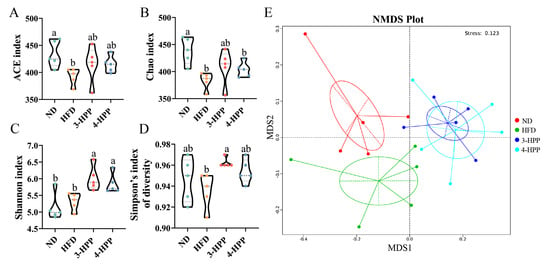
Figure 4.
The impacts of 3−HPP and 4−HPP on α and β diversity of gut flora. ACE (A), Chao (B), and Shannon (C) indexes. (D) Simpson’s index of diversity ACE. (E) NMDS analysis based on Weighted Unifrac distance. Data are expressed as mean ± SD. n = 5 if not specified. According to Duncan’s test, mean values with different letters denote significant differences at p < 0.05.
3.5. HPPs Modulated the Composition of Gut Flora
The results of taxonomic analysis at phylum and genus levels further displayed gut microbiota composition changes (Supplementary Figure S1). The relative abundance of five main phyla is shown in Figure 5. Among the four groups of mice, phylum Firmicutes (50.29%) and Bacteroidetes (32.25%) were most widespread, followed by unidentified_Bacteria (6.16%), Verrucomicrobia (2.17%) and Deferribacteres (1.5%). HFD feeding not only increased the relative abundance of Firmicutes and the ratio of Firmicutes to Bacteroidetes (F/B) but also decreased the relative abundance of Bacteroidetes and unidentified_Bacteria, which was partially reversed by 3-HPP and 4-HPP administration (Figure 5A–D). These treatments did not affect the relative abundance of Deferribacteres or Verrucomicrobia (Figure 5E,F).
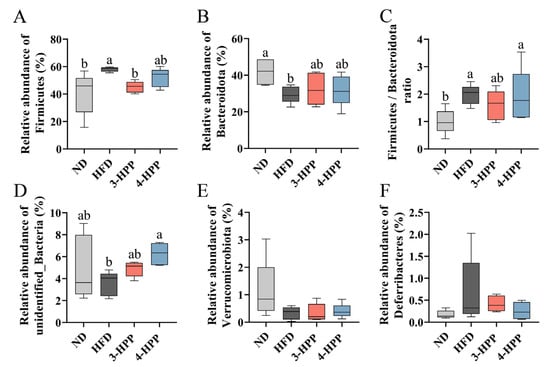
Figure 5.
The effects of 3−HPP and 4−HPP on the relative abundance of gut microbiota at the phylum level. Relative abundance of Firmicutes (A), Bacteroidetes (B), unidentified_Bacteria (D), Verrucomicrobita (E), and Deferribacteres (F). (C) The ratio of Firmicutes to Bacteroidetes. Data are expressed as means ± SDs. n = 5 if not specified. According to Duncan’s test, mean values with different letters denote significant differences at p < 0.05.
The relative abundance of the top 10 genera accounted for 43% of the total; the top 10 genera were Blautia, Rikenellaceae_RC9_gut_group, Dubosiella, Bacteroides, Akkermansia, Ruminococcus, Lactobacillus, Ligilactobacillus and Alistipes (Supplementary Figure S1B). The key genera between the HFD and HPP groups were selected according to a Wilcoxon rank sum test. HFD feeding significantly increased the relative abundance of Desulfovibrio, which is related to inflammation (Figure 6A). With 3-HPP and 4-HPP treatment, the relative abundance of GCA-900066575, unidentified_Lachnospiraceae, and Lachnospiraceae_UCG-006 increased, which belong to Lachnospiraceae family (Figure 6B–D,G–I).
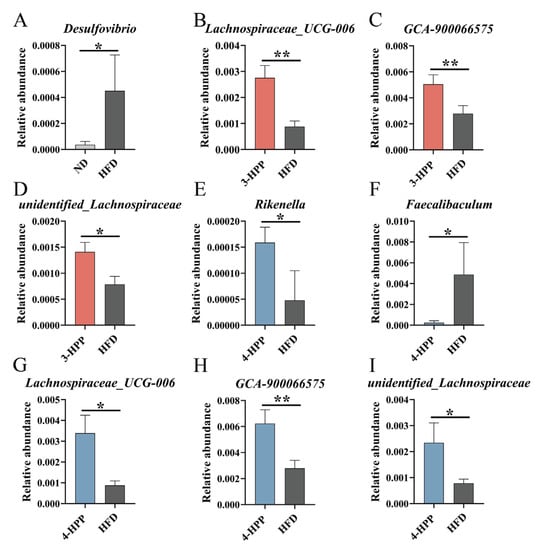
Figure 6.
The effects of 3−HPP and 4−HPP on the relative abundance of key genera in different groups. Relative abundance of Desulfovibrio (A) between the ND and HFD groups. Relative abundance of Lachnospiraceae_UCG-006 (B), GCA-900066575 (C), and unidentified_Lachnospiraceae (D) between the 3−HPP and HFD groups. Relative abundance of Rikenella (E), Faecalibaculum (F), Lachnospiraceae_UCG-006 (G), GCA-900066575 (H), and unidentified_Lachnospiraceae (I) between the 4−HPP and HFD groups. Data are expressed as means ± SDs. n = 5 if not specified. The results were analysed by a Wilcoxon rank sum test. * p < 0.05 and ** p < 0.01 compared to the HFD group.
3.6. HPPs Affected the Predicted Functions and SCFAs Production of Gut Flora
OTUs from 16S rRNA sequencing were selected to predict the distinction in metabolic function between HFD and HPP groups by combining the PICRUSt2 and KEGG databases. HFD feeding upregulated nitrogen metabolism and enriched amino acid metabolism in comparison with ND feeding (Supplementary Figure S2). By contrast to HFD group, the 3-HPP group markedly increased valine, leucine and isoleucine biosynthesis (Figure 7A). The administration of 4-HPP inhibited lipid biosynthesis and glycosyltransferases and increased lipid metabolism, which is useful for explaining the beneficial efficacy of 4-HPP for hepatic and serum fat contents (Figure 7B).
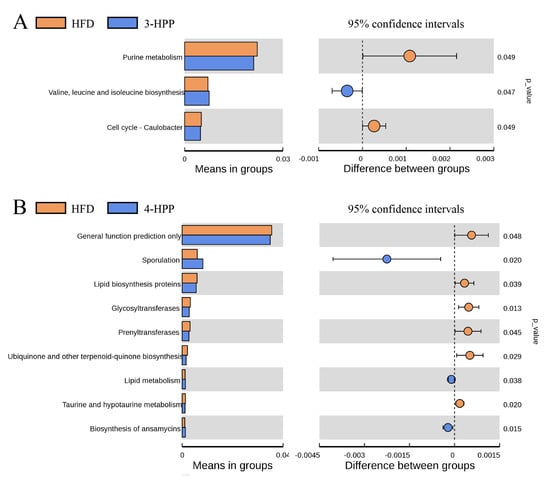
Figure 7.
The effects of 3−HPP and 4−HPP on the predicated metabolic profile of gut microbiota. (A) Comparison between HFD and 3−HPP. (B) Comparison between HFD and 4−HPP. The key metabolic pathways predicted by PICRUSt2 and KEGG were selected based on a t-test at p < 0.05. n = 5 if not specified. The colour of the circle is the same as the group with a higher function. The line segment indicates the 95% confidence interval.
In addition to the disruption of metabolic function, the content of acetic acid, propanoic acid, hexanoic acid, and isohexanoic acid in HFD mice was distinctly reduced when compared to ND mice. Nevertheless, 3-HPP and 4-HPP obviously enriched concentrations of most SCFAs except for isohexanoic acid (Figure 8A–H). These data suggested that HPPs could effectively regulate the content of SCFAs.
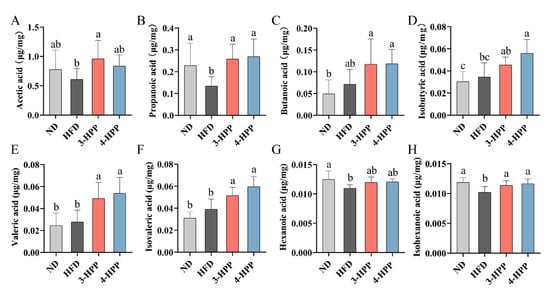
Figure 8.
The effects of 3−HPP and 4−HPP on SCFAs content of feces. Fecal concentrations of acetic acid (A), propanoic acid (B), butanoic acid (C), isobutyric acid (D), valeric acid (E), isovaleric acid (F), hexanoic acid (G), and isohexanoic acid (H). n = 6 if not specified. According to Duncan’s test, mean values with different letters mean significant differences at p < 0.05.
4. Discussion
NAFLD is becoming an increasingly serious public health problem, with high prevalence among both children and adults [37]. Long-term HFD-induced mice models have been widely used to investigate NAFLD development. In this study, HFD feeding for 13 weeks increased BW and liver index and induced dyslipidemia, which is parallel to NAFLD development in humans and other models [38,39]. The use of 3-HPP and 4-HPP supplementation not only significantly reduced liver index and BW but also lessened the contents of TG, LDL-c, and TC in serum. We found 4-HPP was more effective at reducing lipid levels in the liver and serum. These efficacies of HPPs were similar to those of other phenolic acids such as caffeic and chlorogenic acid [40,41]. Although HPPs had few impacts on gene expression of lipogenesis, they improved mRNA expression of PPARα. PPARα is a nuclear receptor with pivotal regulation functions in fatty acid oxidation, transport, and ketogenesis [42]. Chi et al. found that zinc complex of ulvan oligosaccharide enhanced fatty acid oxidation in the liver via the metal regulatory transcription factor 1/PPARα pathway [43]. As fatty acid is the main material for TG synthesis, HPPs might alleviate hypertriglyceridemia by activating hepatic PPARα gene expression to reduce fatty acid levels.
The liver is the major organ for lipid metabolism and excessive hepatic lipid accumulation can induce NAFLD. Liver biopsies of NAFLD patients show pathological changes such as lipid vacuole, lobular inflammation and hepatocellular ballooning [44]. Increments in ALT and AST levels in serum are associated with NAFLD and liver damage [33]. Interestingly, we found that 3-HPP and 4-HPP prevented pathological changes in the livers of HFD mice and increased serum ALT and AST levels. These results suggest that HPPs treatment ameliorates hepatic steatosis and liver injury. Accordingly, Cui et al. found that 3-HPP from dietary acteoside could ameliorate oxidative stress, decreasing lipid peroxidation, and reducing inflammation in the acute liver injury mice model, which demonstrated the hepatoprotective effect of 3-HPP [21]. Based on beneficial impacts of HPPs on NAFLD, their mechanism of improving NAFLD was further investigated by 16S rRNA sequencing.
Gut microbiota played critical roles in host metabolism and health. Recent evidence indicates that gut microbiota is related to NAFLD and could be a targeted therapy [9,45]. Shen found that the diversity and abundance of gut flora are lower in NAFLD patients compared to healthy subjects [46]. In our study, an HFD reduced the diversity and richness of gut microbiota, and this was reversed by 3-HPP and 4-HPP treatment. The results of NMDS showed that HFD feeding and HPPs supplement influenced the composition and structure of intestinal microbiota, indicating that HPPs can modulate gut microbiota. In this study, HFD feeding upregulated the relative abundance of Firmicutes and downregulated the relative abundance of Bacteroidetes, which caused the F/B ratio to increase. These changes in phylum have also been observed in other NAFLD models and obese humans [36,47]. HPPs administration tended to reduce the ratio of F/B. The relative abundance of Dubosiella genera was lower and the relative abundance of Desulfovibrio genera was higher in HFD mice compared to ND mice. Dubosiella, part of the Erysipelotrichaceae family, has a negative correlation with the gene expression of tumor necrosis factor-α and interleukin-1β [48]. Desulfovibrio, a kind of sulphate-reducing bacteria, is enriched in gastric cancer patients and its metabolite (hydrogen sulphide) induces the production of NO and IL-1β to promote inflammation [49]. The change in the relative abundance of Dubosiella and Desulfovibrio in HFD mice reflected gut dysbiosis during NAFLD. 3-HPP and 4-HPP administration improved the relative abundance of genera such as GCA-900066575, unidentified_Lachnospiraceae, and Lachnospiraceae_UCG-006, part of the Lachnospiraceae family. With 4-HPP treatment, the relative abundance of Rikenella genera and Faecalibaculum genera increased and decreased, respectively. The Lachnospiraceae family and Rikenella genera are the producers of SCFA [50,51]. Faecalibaculum, a proinflammatory genus, can induce depression-like phenotypes [52,53]. The regulation of 3-HPP and 4-HPP concerning the structure and composition of gut microbiota partly explained their amelioration of gut dysbiosis, and 4-HPP modulated gut microbiota composition to a stronger extent than 3-HPP. Cueva et al. discovered that 4-HPP was more effective than 3-HPP in inhibiting the growth of Lactobacilli, E. coli, and Staphylococcus aureus strains, which could explain the better impacts of 4-HPP on gut microbiota [54].
The regulation of gut microbiota on host metabolism majorly depended on its metabolic functions and metabolites, except for relying on its composition and abundance. SCFAs, such as propionate, butyrate, and acetate, are microbial products from carbohydrate fermentation. After utilization of enterocytes, SCFAs could enter the liver by portal vein transport to regulate hepatic lipid metabolism [55]. den Besten et al. discovered that sodium of propionate, acetate, and butyrate shifted hepatic lipogenesis to lipid oxidation by activating AMP-activated protein kinase/PPARγ signal pathway [56]. In our results, HPPs enhanced colonic production of acetic acid, propanoic acid, and other SCFAs, which partly explained the lipid-lowering effect of HPPs.
Endotoxins come from gram-negative bacteria and are a causative agent of NAFLD [35]. Wu et al. found that an HFD increased endotoxin levels in the serum and livers of NAFLD mice [57]. In our study, long-term HFD feeding also increased endotoxin levels in serum and this was reversed by 3-HPP and 4-HPP administration. In addition, HPPs enriched fecal content of butanoic acid. It has been suggested that butyrate could ameliorate gut barriers impairment by upregulating the expression of zonula occluden-1 and decrease inflammation by promoting generation of interleukin-22 through regulating histone deacetylase and G-protein receptor 41 [58,59]. Therefore, the systematic inflammation induced by endotoxin might be ameliorated by enrichment of butanoic acid through HPPs. The mechanism by which 3-HPP and 4-HPP reduce endotoxin content remains unclear and requires further investigation.
5. Conclusions
In conclusion, 3-HPP and 4-HPP significantly ameliorated the degree of NAFLD in mice models by reducing liver and serum lipid contents, thereby alleviating hepatic steatosis, inhibiting liver injury, and reducing endotoxin levels in serum. The results of high-throughput 16S rRNA gene sequencing showed that HPPs administration enhanced the diversity of gut microbiota and had a tendency to reduce the ratio of F/B. We found that 4-HPP treatment enriched Rikenella genera and reduced the relative abundance of Faecalibaculum. Furthermore, 4-HPP was more active than 3-HPP in decreasing lipid content and modulating gut microbiota. The causality between gut microbiota and the protective effects of HPPs for NAFLD is an interesting topic for future research. Our findings provide a valuable foundation for NAFLD prevention by HPPs.
Supplementary Materials
The following supporting information can be downloaded at https://www.mdpi.com/article/10.3390/nu15041043/s1. Figure S1: The relative abundance of microbiota in ND, HFD, 3-HPP and 4-HPP groups; Figure S2: A comparison between the ND and HFD groups of the predicated metabolic profiles of gut microbiota.
Author Contributions
J.G.: Methodology, Conceptualization, Validation, Writing—original draft, Writing—review and editing. P.W.: Writing—review and editing, Data curation, Formal analysis, Supervision. Y.C.: Visualization, Software, Writing—review and editing. X.H.: Writing—supervision, Project administration, Validation. F.C.: Writing—review and editing, Resources, C.M.: Investigation, Funding acquisition, Supervision, Writing—review and editing. All authors have read and agreed to the published version of the manuscript.
Funding
This research was funded by Beijing Innovation Consortium of Agriculture Research System (BAIC01-2022); Beijing Municipal Science and Technology Project (D16110500540000); and National Key Research and Development Program of China (2017YFD0400705).
Institutional Review Board Statement
The protocols of this study were approved by the Animal Care and Ethics Committee of China Agricultural University (Ethics reference number: AW70702202-4-1) and followed the guidelines of the National Research Council Guidelines.
Informed Consent Statement
Not applicable.
Data Availability Statement
Data are available from the corresponding author on reasonable request.
Conflicts of Interest
The authors declare no conflict of interest.
References
- Powell, E.E.; Wong, V.W.S.; Rinella, M. Non-alcoholic fatty liver disease. Lancet 2021, 397, 2212–2224. [Google Scholar] [CrossRef] [PubMed]
- Friedman, S.L.; Neuschwander-Tetri, B.A.; Rinella, M.; Sanyal, A.J. Mechanisms of NAFLD development and therapeutic strategies. Nat. Med. 2018, 24, 908–922. [Google Scholar] [CrossRef] [PubMed]
- Loomba, R.; Friedman, S.L.; Shulman, G.I. Mechanisms and disease consequences of nonalcoholic fatty liver disease. Cell 2021, 184, 2537–2564. [Google Scholar] [CrossRef] [PubMed]
- Ipsen, D.H.; Lykkesfeldt, J.; Tveden-Nyborg, P. Molecular mechanisms of hepatic lipid accumulation in non-alcoholic fatty liver disease. Cell. Mol. Life Sci. 2018, 75, 3313–3327. [Google Scholar] [CrossRef]
- Li, H.; Yu, X.H.; Ou, X.; Ouyang, X.P.; Tang, C.K. Hepatic cholesterol transport and its role in non-alcoholic fatty liver disease and atherosclerosis. Prog. Lipid Res. 2021, 83, 101109. [Google Scholar] [CrossRef]
- Sonnenburg, J.L.; Bäckhed, F. Diet–microbiota interactions as moderators of human metabolism. Nature 2016, 535, 56–64. [Google Scholar] [CrossRef]
- Schoeler, M.; Caesar, R. Dietary lipids, gut microbiota and lipid metabolism. Rev. Endocr. Metab. Disord. 2019, 20, 461–472. [Google Scholar] [CrossRef]
- Sanyal, A.J. Past, present and future perspectives in nonalcoholic fatty liver disease. Nat. Rev. Gastroenterol. Hepatol. 2019, 16, 377–386. [Google Scholar] [CrossRef]
- Kolodziejczyk, A.A.; Zheng, D.P.; Shibolet, O.; Elinav, E. The role of the microbiome in NAFLD and NASH. Embo Mol. Med. 2019, 11, e9302. [Google Scholar] [CrossRef]
- Aron-Wisnewsky, J.; Vigliotti, C.; Witjes, J.; Le, P.; Holleboom, A.G.; Verheij, J.; Nieuwdorp, M.; Clement, K. Gut microbiota and human NAFLD: Disentangling microbial signatures from metabolic disorders. Nat. Rev. Gastroenterol. Hepatol. 2020, 17, 279–297. [Google Scholar] [CrossRef]
- Demir, M.; Lang, S.; Hartmann, P.; Duan, Y.; Martin, A.; Miyamoto, Y.; Bondareva, M.; Zhang, X.; Wang, Y.; Kasper, P.; et al. The fecal mycobiome in non-alcoholic fatty liver disease. J. Hepatol. 2022, 76, 788–799. [Google Scholar] [CrossRef]
- Zhuge, A.; Li, S.; Lou, P.; Wu, W.; Wang, K.; Yuan, Y.; Xia, J.; Li, B.; Li, L. Longitudinal 16S rRNA sequencing reveals relationships among alterations of gut microbiota and nonalcoholic fatty liver disease progression in mice. Microbiol. Spectr. 2022, 10, 47–52. [Google Scholar] [CrossRef]
- Rabot, S.; Membrez, M.; Bruneau, A.; Gerard, P.; Harach, T.; Moser, M.; Raymond, F.; Mansourian, R.; Chou, C.J. Germ-free C57BL/6J mice are resistant to high-fat-diet-induced insulin resistance and have altered cholesterol metabolism. Faseb J. 2010, 24, 4948–4959. [Google Scholar]
- Safari, Z.; Gerard, P. The links between the gut microbiome and non-alcoholic fatty liver disease (NAFLD). Cell. Mol. Life Sci. 2019, 76, 1541–1558. [Google Scholar] [CrossRef]
- Whitfield, C.; Trent, M.S. Biosynthesis and export of bacterial lipopolysaccharides. Annu. Rev. Biochem. 2014, 83, 99–128. [Google Scholar] [CrossRef]
- Kessoku, T.; Kobayashi, T.; Tanaka, K.; Yamamoto, A.; Takahashi, K.; Iwaki, M.; Ozaki, A.; Kasai, Y.; Nogami, A.; Honda, Y.; et al. The role of leaky gut in nonalcoholic fatty liver disease: A novel therapeutic target. Int. J. Mol. Sci. 2021, 22, 8161. [Google Scholar] [CrossRef]
- Chen, X.; Zhang, C.; Zhao, M.; Shi, C.-E.; Zhu, R.-M.; Wang, H.; Zhao, H.; Wei, W.; Li, J.-B.; Xu, D.-X. Melatonin alleviates lipopolysaccharide-induced hepatic SREBP-1c activation and lipid accumulation in mice. J. Pineal Res. 2011, 51, 416–425. [Google Scholar] [CrossRef]
- Ohtani, N.; Hara, E. Gut-liver axis-mediated mechanism of liver cancer: A special focus on the role of gut microbiota. Cancer Sci. 2021, 112, 4433–4443. [Google Scholar] [CrossRef]
- Kimura, I.; Ozawa, K.; Inoue, D.; Imamura, T.; Kimura, K.; Maeda, T.; Terasawa, K.; Kashihara, D.; Hirano, K.; Tani, T.; et al. The gut microbiota suppresses insulin-mediated fat accumulation via the short-chain fatty acid receptor GPR43. Nat. Commun. 2013, 4, 1829. [Google Scholar] [CrossRef]
- Wang, P.; Gao, J.; Ke, W.; Wang, J.; Li, D.; Liu, R.; Jia, Y.; Wang, X.; Chen, X.; Chen, F.; et al. Resveratrol reduces obesity in high-fat diet-fed mice via modulating the composition and metabolic function of the gut microbiota. Free Radic. Biol. Med. 2020, 156, 83–98. [Google Scholar] [CrossRef]
- Cui, Q.L.; Pan, Y.N.; Zhang, W.; Zhang, Y.A.; Ren, S.M.; Wang, D.M.; Wang, Z.Z.; Liu, X.Q.; Xiao, W. Metabolites of dietary acteoside: Profiles, isolation, identification, and hepatoprotective capacities. J. Agric. Food Chem. 2018, 66, 2660–2668. [Google Scholar] [CrossRef] [PubMed]
- Selma, M.V.; Espín, J.C.; Tomás-Barberán, F.A. Interaction between phenolics and gut microbiota: Role in human health. J. Agric. Food Chem. 2009, 57, 6485–6501. [Google Scholar] [CrossRef] [PubMed]
- Monagas, M.; Urpi-Sarda, M.; Sánchez-Patán, F.; Llorach, R.; Garrido, I.; Gómez-Cordovés, C.; Andres-Lacueva, C.; Bartolomé, B. Insights into the metabolism and microbial biotransformation of dietary flavan-3-ols and the bioactivity of their metabolites. Food Funct. 2010, 1, 233–253. [Google Scholar] [CrossRef] [PubMed]
- Ward, N.C.; Croft, K.D.; Puddey, I.B.; Hodgson, J.M. Supplementation with grape seed polyphenols results in increased urinary excretion of 3-hydroxyphenylpropionic Acid, an important metabolite of proanthocyanidins in humans. J. Agric. Food Chem. 2004, 52, 5545–5549. [Google Scholar] [CrossRef]
- Khairudin, M.A.S.; Mhd Jalil, A.M.; Hussin, N. Effects of polyphenols in tea (Camellia sinensis sp.) on the modulation of gut microbiota in human trials and animal studies. Gastroenterol. Insights 2021, 12, 202–216. [Google Scholar] [CrossRef]
- Shen, L.; Ji, H.-F. Reciprocal interactions between resveratrol and gut microbiota deepen our understanding of molecular mechanisms underlying its health benefits. Trends Food Sci. Technol. 2018, 81, 232–236. [Google Scholar] [CrossRef]
- Makarewicz, M.; Drozdz, I.; Tarko, T.; Duda-Chodak, A. The interactions between polyphenols and microorganisms, especially gut microbiota. Antioxidants 2021, 10, 188. [Google Scholar] [CrossRef]
- Guo, J.L.; Wang, P.; Cui, Y.F.; Hu, X.S.; Chen, F.; Ma, C. Alleviation effects of microbial metabolites from resveratrol on non-alcoholic fatty liver disease. Foods 2023, 12, 94. [Google Scholar] [CrossRef]
- Wang, J.; Wang, P.; Li, D.; Hu, X.; Chen, F. Beneficial effects of ginger on prevention of obesity through modulation of gut microbiota in mice. Eur. J. Nutr. 2020, 59, 699–718. [Google Scholar] [CrossRef]
- Ke, W.X.; Wang, P.; Wang, X.H.; Zhou, X.L.; Hu, X.S.; Chen, F. Dietary platycodon grandiflorus attenuates hepatic insulin resistance and oxidative stress in high-fat-diet induced non-alcoholic fatty liver disease. Nutrients 2020, 12, 480. [Google Scholar] [CrossRef]
- Li, D.; Feng, Y.; Tian, M.; Ji, J.; Hu, X.; Chen, F. Gut microbiota-derived inosine from dietary barley leaf supplementation attenuates colitis through PPAR gamma signaling activation. Microbiome 2021, 9, 83. [Google Scholar] [CrossRef]
- Hsu, Y.-L.; Chen, C.-C.; Lin, Y.-T.; Wu, W.-K.; Chang, L.-C.; Lai, C.-H.; Wu, M.-S.; Kuo, C.-H. Evaluation and optimization of sample handling methods for quantification of short-chain fatty acids in human fecal samples by GC-MS. J. Proteome Res. 2019, 18, 1948–1957. [Google Scholar] [CrossRef]
- He, M.M.; Fang, Z.; Hang, D.; Wang, F.; Polychronidis, G.; Wang, L.; Lo, C.H.; Wang, K.; Zhong, R.; Knudsen, M.D.; et al. Circulating liver function markers and colorectal cancer risk: A prospective cohort study in the UK Biobank. Int. J. Cancer 2021, 148, 1867–1878. [Google Scholar] [CrossRef]
- Martin, A.; Lang, S.; Goeser, T.; Demir, M.; Steffen, H.M.; Kasper, P. Management of dyslipidemia in patients with non-alcoholic fatty liver disease. Curr. Atheroscler. Rep. 2022, 24, 533–546. [Google Scholar] [CrossRef]
- Fei, N.; Bruneau, A.; Zhang, X.J.; Wang, R.R.; Wang, J.X.; Rabot, S.; Gerard, P.; Zhao, L.P. Endotoxin producers overgrowing in human gut microbiota as the causative agents for nonalcoholic fatty liver disease. Mbio 2020, 11, e03263-19. [Google Scholar] [CrossRef]
- Backhed, F.; Ding, H.; Wang, T.; Hooper, L.V.; Koh, G.Y.; Nagy, A.; Semenkovich, C.F.; Gordon, J.I. The gut microbiota as an environmental factor that regulates fat storage. Proc. Natl. Acad. Sci. USA 2004, 101, 15718–15723. [Google Scholar] [CrossRef]
- Younossi, Z.; Tacke, F.; Arrese, M.; Sharma, B.C.; Mostafa, I.; Bugianesi, E.; Wai-Sun Wong, V.; Sun, W.; Yilmaz, Y.; George, J.; et al. Global perspectives on nonalcoholic fatty liver disease and nonalcoholic steatohepatitis. Hepatology 2019, 69, 2672–2682. [Google Scholar] [CrossRef]
- Ryan, M.C.; Wilson, A.M.; Slavin, J.; Best, J.D.; Jenkins, A.J.; Desmond, P.V. Associations between liver histology and severity of the metabolic syndrome in subjects with nonalcoholic fatty liver disease. Diabetes Care 2005, 28, 1222–1224. [Google Scholar] [CrossRef]
- Zhu, M.Z.; Hao, S.J.; Liu, T.; Yang, L.L.; Zheng, P.Y.; Zhang, L.; Ji, G. Lingguizhugan decoction improves non-alcoholic fatty liver disease by altering insulin resistance and lipid metabolism related genes: A whole trancriptome study by RNA-Seq. Oncotarget 2017, 8, 82621–82631. [Google Scholar] [CrossRef]
- Mu, H.N.; Zhou, Q.; Yang, R.Y.; Tang, W.Q.; Li, H.X.; Wang, S.M.; Li, J.; Chen, W.X.; Dong, J. Caffeic acid prevents non-alcoholic fatty liver disease induced by a high-fat diet through gut microbiota modulation in mice. Food Res. Int. 2021, 143, 110240. [Google Scholar] [CrossRef]
- Shi, A.M.; Li, T.; Zheng, Y.; Song, Y.H.; Wang, H.T.; Wang, N.; Dong, L.; Shi, H.T. Chlorogenic Acid Improves NAFLD by Regulating gut Microbiota and GLP-1. Front. Pharmacol. 2021, 12, 693048. [Google Scholar] [CrossRef] [PubMed]
- Montaigne, D.; Butruille, L.; Staels, B. PPAR control of metabolism and cardiovascular functions. Nat. Rev. Cardiol. 2021, 18, 809–823. [Google Scholar] [CrossRef] [PubMed]
- Chi, Y.; Wu, Z.; Du, C.; Zhang, M.; Wang, X.; Xie, A.; Wang, P.; Li, R. Regulatory effects mediated by ulvan oligosaccharide and its zinc complex on lipid metabolism in high-fat diet-fed mice. Carbohydr. Polym. 2023, 300, 120249. [Google Scholar] [CrossRef] [PubMed]
- Nalbantoglu, I.; Brunt, E.M. Role of liver biopsy in nonalcoholic fatty liver disease. World J. Gastroenterol. 2014, 20, 9026–9037. [Google Scholar]
- Leung, C.; Rivera, L.; Furness, J.B.; Angus, P.W. The role of the gut microbiota in NAFLD. Nat. Rev. Gastroenterol. Hepatol. 2016, 13, 412–425. [Google Scholar] [CrossRef]
- Shen, F.; Zheng, R.D.; Sun, X.Q.; Ding, W.J.; Wang, X.Y.; Fan, J.G. Gut microbiota dysbiosis in patients with non-alcoholic fatty liver disease. Hepatobiliary Pancreat. Dis. Int. 2017, 16, 375–381. [Google Scholar] [CrossRef]
- Hu, W.B.; Gao, W.Y.; Liu, Z.M.; Fang, Z.F.; Wang, H.C.; Zhao, J.X.; Zhang, H.; Lu, W.W.; Chen, W. Specific strains of Faecalibacterium prausnitzii ameliorate nonalcoholic fatty liver disease in mice in association with gut microbiota regulation. Nutrients 2022, 14, 2945. [Google Scholar] [CrossRef]
- Wan, F.; Han, H.; Zhong, R.Q.; Wang, M.Y.; Tang, S.L.; Zhang, S.F.; Hou, F.J.; Yi, B.; Zhang, H.F. Dihydroquercetin supplement alleviates colonic inflammation potentially through improved gut microbiota community in mice. Food Funct. 2021, 12, 11420–11434. [Google Scholar] [CrossRef]
- Liu, S.L.; Dai, J.J.; Lan, X.; Fan, B.B.; Dong, T.Y.; Zhang, Y.; Han, M.Y. Intestinal bacteria are potential biomarkers and therapeutic targets for gastric cancer. Microb. Pathog. 2021, 151, 104747. [Google Scholar] [CrossRef]
- Vacca, M.; Celano, G.; Calabrese, F.M.; Portincasa, P.; Gobbetti, M.; De Angelis, M. The controversial role of human gut Lachnospiraceae. Microorganisms 2020, 8, 573. [Google Scholar] [CrossRef]
- Shi, H.J.; Chang, Y.G.; Gao, Y.; Wang, X.; Chen, X.; Wang, Y.M.; Xue, C.H.; Tang, Q.J. Dietary fucoidan of Acaudina molpadioides alters gut microbiota and mitigates intestinal mucosal injury induced by cyclophosphamide. Food Funct. 2017, 8, 3383–3393. [Google Scholar] [CrossRef]
- Cai, W.; Xu, J.X.; Li, G.; Liu, T.; Guo, X.L.; Wang, H.J.; Luo, L.P. Ethanol extract of propolis prevents high-fat diet-induced insulin resistance and obesity in association with modulation of gut microbiota in mice. Food Res. Int. 2020, 130, 108939. [Google Scholar] [CrossRef]
- Wang, S.M.; Ishima, T.; Qu, Y.; Shan, J.J.; Chang, L.J.; Wei, Y.; Zhang, J.C.; Pu, Y.Y.; Fujita, Y.; Tan, Y.F.; et al. Ingestion of Faecalibaculum rodentium causes depression-like phenotypes in resilient Ephx2 knock-out mice: A role of brain-gut-microbiota axis via the subdiaphragmatic vagus nerve. J. Affect. Disord. 2021, 292, 565–573. [Google Scholar] [CrossRef]
- Cueva, C.; Victoria Moreno-Arribas, M.; Martin-Alvarez, P.J.; Bills, G.; Francisca Vicente, M.; Basilio, A.; Lopez Rivas, C.; Requena, T.; Rodriguez, J.M.; Bartolome, B. Antimicrobial activity of phenolic acids against commensal, probiotic and pathogenic bacteria. Res. Microbiol. 2010, 161, 372–382. [Google Scholar] [CrossRef]
- Schoenfeld, P.; Wojtczak, L. Short- and medium-chain fatty acids in energy metabolism: The cellular perspective. J. Lipid Res. 2016, 57, 943–954. [Google Scholar] [CrossRef]
- den Besten, G.; Bleeker, A.; Gerding, A.; van Eunen, K.; Havinga, R.; van Dijk, T.H.; Oosterveer, M.H.; Jonker, J.W.; Groen, A.K.; Reijngoud, D.-J.; et al. Short-chain fatty acids protect against high-fat diet-induced obesity via a PPAR-dependent switch from lipogenesis to fat oxidation. Diabetes 2015, 64, 2398–2408. [Google Scholar] [CrossRef]
- Wu, S.S.; Hu, R.Z.; Nakano, H.; Chen, K.Y.; Liu, M.; He, X.; Zhang, H.F.; He, J.H.; Hou, D.X. Modulation of gut microbiota by Lonicera caerulea L. Berry polyphenols in a mouse model of fatty liver induced by high fat diet. Molecules 2018, 23, 3213. [Google Scholar] [CrossRef]
- Zhou, D.; Pan, Q.; Xin, F.-Z.; Zhang, R.-N.; He, C.-X.; Chen, G.-Y.; Liu, C.; Chen, Y.-W.; Fan, J.-G. Sodium butyrate attenuates high-fat diet-induced steatohepatitis in mice by improving gut microbiota and gastrointestinal barrier. World J. Gastroenterol. 2017, 23, 60–75. [Google Scholar] [CrossRef]
- Yang, W.; Yu, T.; Huang, X.; Bilotta, A.J.; Xu, L.; Lu, Y.; Sun, J.; Pan, F.; Zhou, J.; Zhang, W.; et al. Intestinal microbiota-derived short-chain fatty acids regulation of immune cell IL-22 production and gut immunity. Nat. Commun. 2020, 11, 4457. [Google Scholar] [CrossRef]
Disclaimer/Publisher’s Note: The statements, opinions and data contained in all publications are solely those of the individual author(s) and contributor(s) and not of MDPI and/or the editor(s). MDPI and/or the editor(s) disclaim responsibility for any injury to people or property resulting from any ideas, methods, instructions or products referred to in the content. |
© 2023 by the authors. Licensee MDPI, Basel, Switzerland. This article is an open access article distributed under the terms and conditions of the Creative Commons Attribution (CC BY) license (https://creativecommons.org/licenses/by/4.0/).